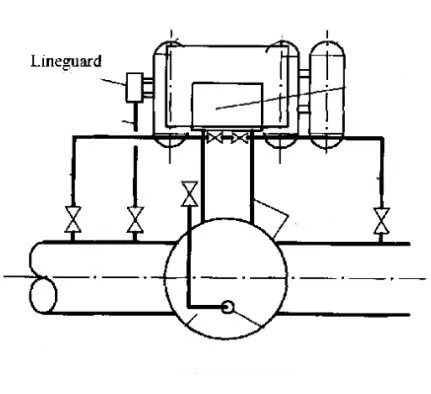Automatic Shutdown Function Not Present in Normal Circumstances:
Pneumatic-hydraulic actuated ball valves are equipped with pressure upper limits, lower limits, and a pressure drop rate to meet operational requirements. When the pressure inside the pipeline exceeds the upper limit or falls below the lower limit, the ball valve automatically closes. If there is an explosion or damage to the pipeline during operation, the pressure drop detected by the detection device may exceed the pressure drop rate, also causing the ball valve to close.

Multiple Operating Modes:
Pneumatic-hydraulic actuated ball valves offer manual, automatic, remote control, and pneumatic operating modes. Depending on the situation, users can select the appropriate operating mode to ensure the safety of valve operation. When operating manually, personnel need to switch between different gears and operate the hand pump handle to open or close the valve. When using pneumatic operation, operators follow the "left open, right closed" method and manipulate the handle appropriately to achieve the switching function. Additionally, parameters can be set via computer to enable automatic function based on requirements. If the valve is equipped with a remote control unit (RTU), remote control of the valve can be achieved through remote signal transmission.
High Safety:
Pneumatic-hydraulic actuated ball valves use high-pressure natural gas or manual pumps as power sources, eliminating the need for additional mechanical or electrical equipment for power supply. This results in low accident rates and minimal risk, with low associated costs.
Analysis of Failure Causes
Internal Leakage of Ball Valve:
Occurrence During Construction: Various situations contribute to internal leakage during construction, including transportation-related impacts, lack of drying and anticorrosive treatment after completion of quality inspection, inadequate protection during transportation to the construction site leading to exposure to rainwater, mud, etc., and improper welding or lubrication during installation.
Post-Usage Causes: Failure to perform timely maintenance due to high maintenance costs or lack of maintenance measures, inadequate handling during routine cleaning, valve seizure due to lack of regular maintenance, accumulation of rust or dust leading to inability to rotate to the correct position, and interference with valve use due to drying and hardening of valve seal layers.
Leakage of Valve Stem:
Most ball valves have upper and lower seals on the valve stem, which typically do not require maintenance for normal operation. However, prolonged wear or aging may lead to stem leakage. For valves with significant leakage, temporary sealing can be achieved by injecting sealing grease. It is recommended to use a manual grease gun for slow injection, and injection should cease once the leakage stops to prevent difficulty in valve rotation. Over-injection can make valve rotation difficult. Alternatively, depending on the structure, sealing fillers can be injected or pressed onto certain valve stem components for sealing.
Abnormalities During Valve Operation:
1. Valve operation may encounter anomalies due to operational reasons:
2. Valve seizure due to lack of regular maintenance, resulting in difficulties during operation.
3. Condensation of excessive moisture from natural gas transported inside the pipe due to environmental changes during transportation, leading to ice formation and valve closure in cold conditions.
4. Possible pipeline blockages or closure of pipeline speed limit valves due to pneumatic-hydraulic transport.
5. Difficulty in valve operation due to overtightening of the pressure screw by maintenance workers when addressing stem leaks.
This detailed analysis highlights both the robust structural design and potential failure causes of pneumatic-hydraulic actuated ball valves, emphasizing the importance of regular maintenance and proper handling for optimal performance and longevity.
